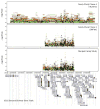Evidence for association of bipolar disorder to haplotypes in the 22q12.3 region near the genes stargazin, IFT27 and parvalbumin
- PMID: 23038240
- PMCID: PMC3665332
- DOI: 10.1002/ajmg.b.32099
Evidence for association of bipolar disorder to haplotypes in the 22q12.3 region near the genes stargazin, IFT27 and parvalbumin
Abstract
We have previously reported genome-wide significant linkage of bipolar disorder to a region on 22q12.3 near the marker D22S278. Towards identifying the susceptibility gene, we have conducted a fine-mapping association study of the region in two independent family samples, an independent case-control sample and a genome-wide association dataset. Two hundred SNPs were first examined in a 5 Mb region surrounding the D22S278 marker in a sample of 169 families and analyzed using PLINK. The peak of association was a haplotype near the genes stargazin (CACNG2), intraflagellar transport protein homolog 27 (IFT27) and parvalbumin (PVALB; P = 4.69 × 10(-4)). This peak overlapped a significant haplotype in a family based association study of a second independent sample of 294 families (P = 1.42 × 10(-5)). Analysis of the combined family sample yielded statistically significant evidence of association to a rare three SNP haplotype in the gene IFT27 (P = 8.89 × 10(-6)). Twelve SNPs comprising these haplotypes were genotyped in an independent sample of 574 bipolar I cases and 550 controls. Statistically significant association was found for a haplotype window that overlapped the region from the first two family samples (P = 3.43 × 10(-4)). However, analyses of the two family samples using the program LAMP, found no evidence for association in this region, but did yield significant evidence for association to a haplotype 3' of CACNG2 (P = 1.76 × 10(-6)). Furthermore, no evidence for association was found in a large genome-wide association dataset. The replication of association to overlapping haplotypes in three independent datasets suggests the presence of a bipolar disorder susceptibility gene in this region.
Copyright © 2012 Wiley Periodicals, Inc.
Figures


References
-
- Badner JA, Gershon ES. Meta-analysis of whole-genome linkage scans of bipolar disorder and schizophrenia. Mol Psychiatry. 2002;7(4):405–411. - PubMed
-
- DeFelipe J. Types of neurons, synaptic connections and chemical characteristics of cells immunoreactive for calbindin-D28K, parvalbumin and calretinin in the neocortex. J Chem Neuroanat. 1997;14(1):1–19. - PubMed
-
- Dick DM, Foroud T, Flury L, Bowman ES, Miller MJ, Rau NL, Moe PR, Samavedy N, El-Mallakh R, Manji H, Glitz DA, Meyer ET, Smiley C, Hahn R, Widmark C, McKinney R, Sutton L, Ballas C, Grice D, Berrettini W, Byerley W, Coryell W, DePaulo R, MacKinnon DF, Gershon ES, Kelsoe JR, McMahon FJ, McInnis M, Murphy DL, Reich T, Scheftner W, Nurnberger JI., Jr Genomewide linkage analyses of bipolar disorder: A new sample of 250 pedigrees from the National Institute of Mental Health Genetics Initiative. Am J Hum Genet. 2003;73(1):107–114. - PMC - PubMed
Publication types
MeSH terms
Substances
Grants and funding
- R01 MH078151/MH/NIMH NIH HHS/United States
- R01 MH059567/MH/NIMH NIH HHS/United States
- U01 MH46282/MH/NIMH NIH HHS/United States
- R01 MH059548/MH/NIMH NIH HHS/United States
- R01 MH059534/MH/NIMH NIH HHS/United States
- R01 MH59535/MH/NIMH NIH HHS/United States
- MH68503/MH/NIMH NIH HHS/United States
- MH081804/MH/NIMH NIH HHS/United States
- T32 GM008666/GM/NIGMS NIH HHS/United States
- M01 RR000827/RR/NCRR NIH HHS/United States
- MH078151/MH/NIMH NIH HHS/United States
- R01 MH060068/MH/NIMH NIH HHS/United States
- MH059567/MH/NIMH NIH HHS/United States
- U01MH46280/MH/NIMH NIH HHS/United States
- R01 MH059556/MH/NIMH NIH HHS/United States
- R01 MH059535/MH/NIMH NIH HHS/United States
- R01 MH59545/MH/NIMH NIH HHS/United States
- R01 MH059545/MH/NIMH NIH HHS/United States
- GM08666/GM/NIGMS NIH HHS/United States
- R01MH59533/MH/NIMH NIH HHS/United States
- Z01 MH002810/ImNIH/Intramural NIH HHS/United States
- 1Z01MH002810-01/MH/NIMH NIH HHS/United States
- M01 RR00827/RR/NCRR NIH HHS/United States
- R01 MH068503/MH/NIMH NIH HHS/United States
- R01 MH59553/MH/NIMH NIH HHS/United States
- U01 MH46274/MH/NIMH NIH HHS/United States
- R01 MH081804/MH/NIMH NIH HHS/United States
- R01 MH60068/MH/NIMH NIH HHS/United States
- R01 MH059533/MH/NIMH NIH HHS/United States
- R01 MH59567/MH/NIMH NIH HHS/United States
- R01 MH059553/MH/NIMH NIH HHS/United States
LinkOut - more resources
Full Text Sources
Medical
Miscellaneous

